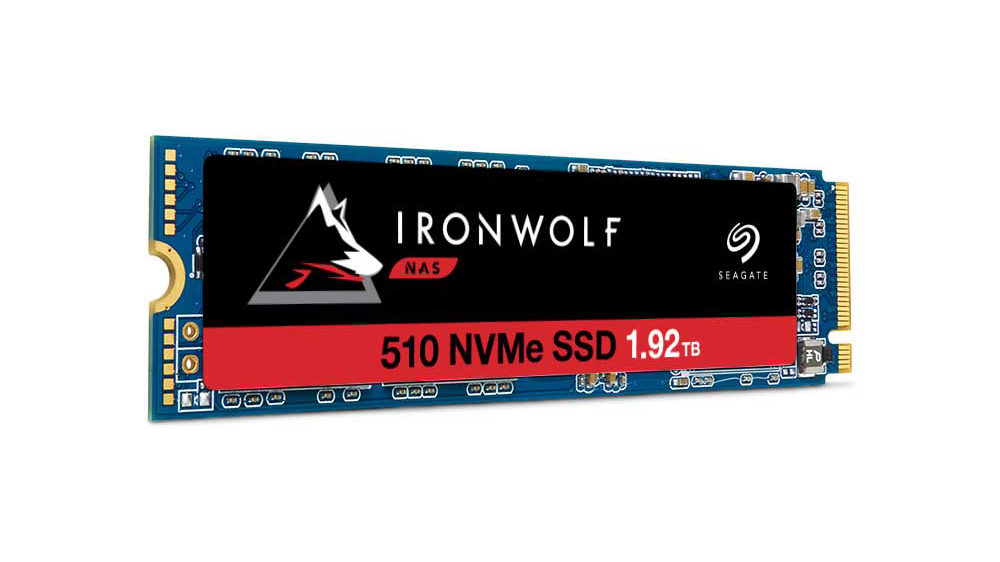Seagate IronWolf 510 ZP1920NM30001 (1.92TB) review: Built for business
Built for SMB NAS caching, this NVMe drive is pricey but has a massive lifespan


-
+
Massive 3500 TBW life expectancy
-
+
Low power consumption
-
-
Expensive

The Seagate IronWolf range is built for NAS (network-attached storage) devices in multi-user environments. It’s aimed at small and medium enterprise deployments and intended to be used as a space-efficient caching drive in devices that support cache acceleration, such as NAS devices and servers with M.2. slots.
Alternatively, its relatively compact, 80mm long, M.2-2280 form factormeans that it could also be used as standard storage in a server, workstation or a NAS with M.2 slots.
Unsurprisingly given its intended purposes, it’s built for endurance, too. Seagate quotes a TBW (total bytes written) lifespan of 3,500TB and backs that up with a five-year warranty and a three-year data recovery plan.
As a caching drive to improve access speeds, the NVMe range’s top-tier 1.92TB Seagate IronWolf 510 ZP1920NM30001-2S9303 is well suited to use alongside around 40TB to 80TB of RAID 1 storage, for example.
Seagate IronWolf 510 ZP1920NM30001 (1.92TB) review: Performance
It uses Triple Layer Cells – which means that three bits are stored per NAND cell, in common with most business and consumer desktop SSDs - and supports NVMe 1.3 on the PCIe x3.0 M.2 interface. These are key factors in performance, and its scores in our benchmark tests reflect them.
A fresh drive connected to a Linux workstation with an AMD Ryzen 3600X CPU and X570 motherboard chipset gave us a sequential write speed of 939MB/sec and a sequential read of 777MB/sec. We got a random write speed of 907MB/sec and random read speed of 846MB/sec.
We run our tests twice, once on a fresh drive, and again on a drive that’s been erased, as a rough indicator of the potential performance impact of using a drive that’s regularly filled up. This time, we got a sequential write speed of 894MB/sec and a random write of 854MB/sec, representing a slowdown of 53 MB/sec and 45MB/sec, respectively.
Sign up today and you will receive a free copy of our Future Focus 2025 report - the leading guidance on AI, cybersecurity and other IT challenges as per 700+ senior executives
Seagate quotes a relatively low average maximum power draw of 6W and idle power consumption of 2W for the 1.92TB IronWolf 510. Management and disk health monitoring tools are available for Windows and Linux, and on compatible NAS devices, including selected models by Synology, QNAP and QSAN, you’ll be able to monitor the disk using Seagate’s IronWolf Health Management suite.
Seagate IronWolf 510 ZP1920NM30001 (1.92TB) review: Verdict
The high capacity, extended durability and commensurate £356 price mean that the IronWolf 510 is likely to be overkill for file server caching in your average office environment, but if you regularly access large amounts of data, it has the performance and life expectancy that you’ll need, whether you’re handling video, images or big data.
K.G. is a journalist, technical writer, developer and software preservationist. Alongside the accumulated experience of over 20 years spent working with Linux and other free/libre/open source software, their areas of special interest include IT security, anti-malware and antivirus, VPNs, identity and password management, SaaS infrastructure and its alternatives.
You can get in touch with K.G. via email at reviews@kgorphanides.com.
-
 Trump's AI executive order could leave US in a 'regulatory vacuum'
Trump's AI executive order could leave US in a 'regulatory vacuum'News Citing a "patchwork of 50 different regulatory regimes" and "ideological bias", President Trump wants rules to be set at a federal level
By Emma Woollacott Published
-
 Microsoft Excel is still alive and kicking at 40 – and it's surging in popularity as 82% of finance professionals report ‘emotional attachment’ to the spreadsheet software
Microsoft Excel is still alive and kicking at 40 – and it's surging in popularity as 82% of finance professionals report ‘emotional attachment’ to the spreadsheet softwareNews A recent survey found Gen Z and Millennial finance professionals have a strong “emotional attachment” to Microsoft Excel
By Emma Woollacott Published
-
 LastPass hit with ICO fine after 2022 data breach exposed 1.6 million users – here’s how the incident unfolded
LastPass hit with ICO fine after 2022 data breach exposed 1.6 million users – here’s how the incident unfoldedNews The impact of the LastPass breach was felt by customers as late as December 2024
By Emma Woollacott Published
